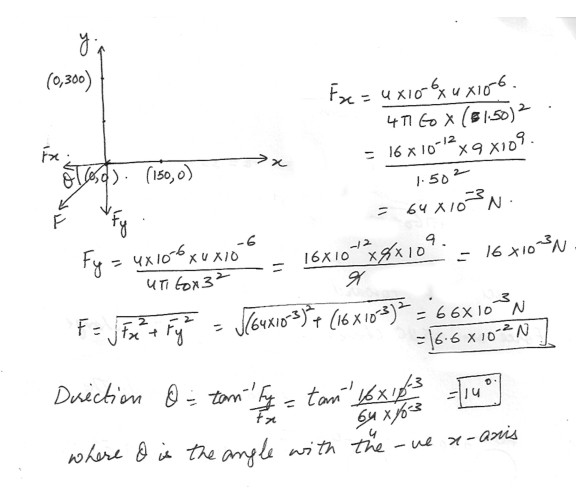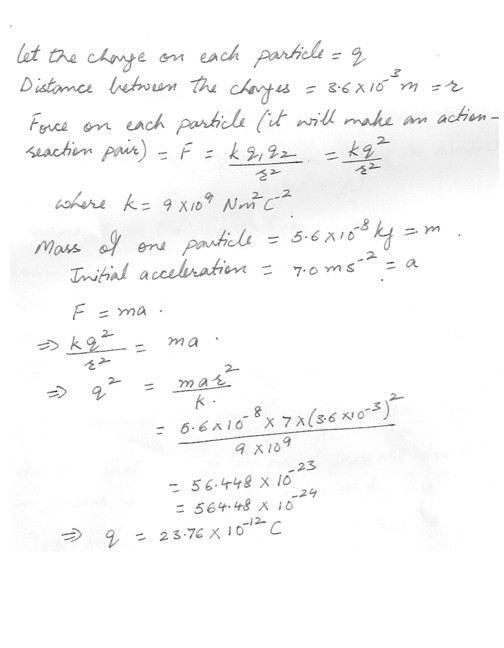Physics Electrostatics Level: High School
Ten joules of work must be done against electric forces to carry a +1 C charge from point A to point B(a) What is the potential difference between A and B ?
(b) How much work is needed to carry a proton from A to B ?

Physics Electrostatics Level: High School
A 2.0 g ball hangs as a pendulum from a very thin thread. It hangs at an angle of 30 degrees when placed in a horizontal field of 5.0 x 10 to the 4th N/C . What is the charge on the ball ?
Physics Electrostatics Level: High School
At what distance from a -5 micro C point charge is the electric field 200 N/C ? Is the electric field there directed radially inward or outward ?
Physics Electrostatics Level: High School
In a certain region of space an electron experiences a force of 3.0 x 10 to the -16th N in the + x direction . What are the magnitude and direction of E in that region ?
Physics Electrostatics Level: High School
Five identical 3.0 micro C exist in a plane . Four are the vertices of a square that has 7.0 m long sides. The fifth is at the center of the square . Find the force on one of the corner charges if the center charges is negative and the others are positive .
Physics Electrostatics Level: High School
The following three charges exist on the x axis : + 5.0 micro C at x = 0 , -3.0 micro C at x = 20 cm , -7.0 micro C at x = 50 cm . Find the magnitude and direction of the force on the -7.0 micro C charge .
Physics Electrostatics Level: High School
Two small identical metal sphere carry charges of + 0.30 micro C and -0.40 micro C.(a) The spheres are 5.0 m apart. Find the force one exerts on the other
(b) The spheres are touched together and again separated to 5.0 m . What force does one now exert on the other ?

Physics Electrostatics Level: High School
Two point charges have values + 5.0 micro C and -7.0 micro C . The +5 micro C charge is at x = 0 whereas the -7 micro C is at x = 30 cm on the x axis.(a) Find the magnitude and direction of the force on the -7 micro C charge .
(b) Repeat for the +5 micro C charge .

Physics Electrostatics Level: High School
Two equally charged particles are held stationary , 3.6 x 10^-3 m apart , and then released . One particle has a mass of 5.6 x 10^-8 kg and is observed to have an initial acceleration of magnitude 7.0 m s^-2 . What is the magnitude of the charge on the particles ?
Physics Electrostatics Level: High School
Each of the two small spheres is positively charged , the combined charge totaling 4 10 – 8 C . What is the charge on each sphere if they are repelled with a force of 2.7 10 - 5 When placed 0.1 metres apart ?
Physics Electrostatics Level: High School
A defibrillator is used to restart a person’s heart after it stops beating . Energ is delivered to the heart by discharging a capacitor through the body tissues near the heart . If the capacitance of the defibrillator is 9 microF and the energy delivered is to be 300 J , to what potential difference must the capacitor be charged ?
Physics Electrostatics Level: High School
A parallel plate capacitor has a charge of 0.020 microC on each plate with a potential difference of 240 V. The parallel plates are separated by 0.40 mm of air . What energy is stored in this capacitor ?
Physics Electrostatics Level: High School
To make a parallel plate capacitor , you have available two flat plates of aluminum (area 120 cm^2) , a sheet of paper (thickness = .100 mm, k = 3.5), a sheet of glass (thickness 2.0 mm, k = 7.0), and a slab of paraffin (thickness = 10.0 mm , k=2.0). What is the largest capacitance possible using one of these diaelectrics ? What is the smallest ?
Physics Electrostatics Level: High School
A parallel plate capacitor has a capacitance of 1.30 nF. There is a charge of magnitude 0.800 microC on each plate . What is the potential difference between the plates ? If the plate separation is doubled , while the charge is kept constant , what will happen to the potential difference ?
Physics Electrostatics Level: High School
A helium nucleus (charge +2 e) moves through a potential difference deltaV = -0.50 kV . Its initial kinetic energy is 1.20 x 10^-16J . What is the final kinetic energy ?
